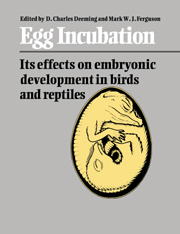Book contents
- Frontmatter
- Contents
- Preface
- Contributors
- 1 Maternal diet, maternal proteins and egg quality
- 2 Comparative composition and utilisation of yolk lipid by embryonic birds and reptiles
- 3 Oviductal proteins and their influence on embryonic development in birds and reptiles
- 4 Fluxes during embryogenesis
- 5 Eggshell structure and formation in eggs of oviparous reptiles
- 6 Shell structure and formation in avian eggs
- 7 Physical characteristics of reptilian eggs and a comparison with avian eggs
- 8 Egg-shape in birds
- 9 The thermal energetics of incubated bird eggs
- 10 Physiological effects of incubation temperature on embryonic development in reptiles and birds
- 11 Cold torpor, diapause, delayed hatching and aestivation in reptiles and birds
- 12 Physical factors affecting the water exchange of buried reptile eggs
- 13 Physiological and ecological importance of water to embryos of oviparous reptiles
- 14 Roles of water in avian eggs
- 15 Water economy and solute regulation of reptilian and avian embryos
- 16 The avian eggshell as a mediating barrier: respiratory gas fluxes and pressures during development
- 17 Gas exchange across reptilian eggshells
- 18 Metabolism and energetics of reptilian and avian embryos
- 19 Reasons for the dichotomy in egg turning in birds and reptiles
- 20 A comparison of reptilian eggs with those of megapode birds
- 21 Why birds lay eggs
- 22 Influences of incubation requirements on the evolution of viviparity
- 23 Overview of early stages of avian and reptilian development
- 24 Ions and ion regulating mechanisms in the developing fowl embryo
- 25 Electrochemical processes during embryonic development
- 26 Methods for shell-less and semi-shell-less culture of avian and reptilian embryos
- 27 Experimental studies on cultured, shell-less fowl embryos: calcium transport, skeletal development, and cardio-vascular functions
- Index
4 - Fluxes during embryogenesis
Published online by Cambridge University Press: 16 November 2009
- Frontmatter
- Contents
- Preface
- Contributors
- 1 Maternal diet, maternal proteins and egg quality
- 2 Comparative composition and utilisation of yolk lipid by embryonic birds and reptiles
- 3 Oviductal proteins and their influence on embryonic development in birds and reptiles
- 4 Fluxes during embryogenesis
- 5 Eggshell structure and formation in eggs of oviparous reptiles
- 6 Shell structure and formation in avian eggs
- 7 Physical characteristics of reptilian eggs and a comparison with avian eggs
- 8 Egg-shape in birds
- 9 The thermal energetics of incubated bird eggs
- 10 Physiological effects of incubation temperature on embryonic development in reptiles and birds
- 11 Cold torpor, diapause, delayed hatching and aestivation in reptiles and birds
- 12 Physical factors affecting the water exchange of buried reptile eggs
- 13 Physiological and ecological importance of water to embryos of oviparous reptiles
- 14 Roles of water in avian eggs
- 15 Water economy and solute regulation of reptilian and avian embryos
- 16 The avian eggshell as a mediating barrier: respiratory gas fluxes and pressures during development
- 17 Gas exchange across reptilian eggshells
- 18 Metabolism and energetics of reptilian and avian embryos
- 19 Reasons for the dichotomy in egg turning in birds and reptiles
- 20 A comparison of reptilian eggs with those of megapode birds
- 21 Why birds lay eggs
- 22 Influences of incubation requirements on the evolution of viviparity
- 23 Overview of early stages of avian and reptilian development
- 24 Ions and ion regulating mechanisms in the developing fowl embryo
- 25 Electrochemical processes during embryonic development
- 26 Methods for shell-less and semi-shell-less culture of avian and reptilian embryos
- 27 Experimental studies on cultured, shell-less fowl embryos: calcium transport, skeletal development, and cardio-vascular functions
- Index
Summary
Introduction
A central problem in understanding the evolution of cellular homeostasis is the recognition that it often involves three systems with no clear inter-relationship in time and space. At some stage, cells produce specific hormone receptors that are linked to particular metabolic pathways and respond to distinctive extracellular molecules. How such functional relationships evolved to cope with a novel situation is a recurrent theme in evolutionary studies and to some extent the same difficulties arise in understanding the development of homeostatic systems in the embryo (Csaba, 1986). In this latter case it is possible to undertake experiments that provide some indication as to how the systems function. This is, however, a relatively recent area of study and the results are frequently unexpected.
Ten years ago, together with Nancy Clark, I attempted to pose some of these problems by studying the onset of calcium homeostasis in the avian embryo. We considered the problem in relation to four general systems: ion diffusion, active transport, passive storage and active resorption and posed a number of fundamental problems (Clark & Simkiss, 1980). In this chapter I will refer to some of the more recent work in these areas taking as examples the problems as they arise chronologically in a developing embryo.
Ion fluxes
Albumen formation
The egg is fertilised at the top of the oviduct and passes down the magnum region where the albumen is secreted.
- Type
- Chapter
- Information
- Egg IncubationIts Effects on Embryonic Development in Birds and Reptiles, pp. 47 - 52Publisher: Cambridge University PressPrint publication year: 1991
- 4
- Cited by



